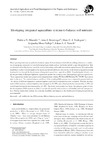Ideotyping integrated aquaculture systems to balance soil nutrients

View/
Date
2011Author
Muendo, Patricia N.
Stoorvogel, Jetse J.
Verdegem, Marc C. J.
Mora-Vallejo, Alejandra
Verreth, Johan A. J.
Metadata
Show full item recordAbstract
Due to growingland scarcityand lack of nutrientinputs, Africanfarmersswitched fromshiftingcultivationto continuous croppingand extendedcrop area by bringing fragile lands such as river banks and hill slopes into production. This accelerated soil fertility decline caused by erosion,harvestingand insufficientnutrient replenishment. We exploredthe feasibility to reduce nutrient depletion by increasing nutrient utilization efficiencies, while diversifyingand increasing food productionthrough the developmentof integrated aquaculture– agriculture (IAA). Considering the climatic conditions prevailing in Kenyan highlands, aquaculture production scenarios were ideotyped per agro-ecological zone. These aquaculture productionscenarios were integrated into existing NUTrient MONitoring (NUTMON) farm survey data for the area. The nutrient balances and flows of the resulting IAA-systems were compared to present land use. The effects of IAA development on nutrient depletion and total food production were evaluated. With the development of IAA systems, nutrient depletion rates dropped by 23–35%, agricultural production increased by 2–26% and overall farm food production increased by 22–70%. The study demonstrates that from a bio-physical point of view, the development of IAA-systems in Africa is technically possible and could raise soil fertility and total farm production. Further studies that evaluate the economic feasibility and impacts on the livelihood of farming households are recommended.
